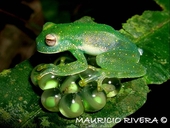|
Description
A small species of glassfrog, with adult females measuring 23.3-23.9 mm SVL and adult males from 19.8-22.6 mm SVL. This species exhibits the following diagnostic characters: 1) vomerine dentition present, 2) bones are pale green, 3) color in life includes white and green spots, 4) rounded snout when viewed dorsally; dorsal skin with low, rounded, white warts, 5) outer margin of the hand, forearm, tarsus, and foot bear a long, thin row of tubercles, 6) humeral spine absent, 7) tympanum large (Ruiz-Carranza and Lynch 1991). Additional characters include: head as wide as body and wider than long (head width 31.0-37.3% SVL); snout rounded in both dorsal and lateral view; distance from nostril to eye is approximately 66.7-95.0% the diameter of the eye; eyes small and do not project beyond border of snout when viewed ventrally; diameter of eye is 26.6-36.4% head length; tibial length 52.3-60.6% SVL; when hind limbs are adpressed anteriorly, the ankle lies between the anterior portion of the eye and the tip of the snout; when forelimbs are adpressed posteriorly and hind limbs adpressed anteriorly, the knees and elbows barely contact one another (Ruiz-Carranza and Lynch 1991).
Distribution and Habitat
Country distribution from AmphibiaWeb's database: Colombia
Known from the western slope of the Cordillera Central of Colombia in the departments of Quindio and Risaralda, counties of Filandia, Salento, Pereira at altitudes between 1980-2410 m, the eastern slope of the Cordillera Central in the department of Caldas, and the western slope of the Cordillera Occidental of Colombia in the department of Valle del Cauca, county La Cumbre at 1800 m. The altitudinal range is 1,400-2,410 m asl (Stuart et al. 2008). Found in sub-Andean forest (including secondary forest) on vegetation adjacent to running water (Stuart et al. 2008).
Life History, Abundance, Activity, and Special Behaviors
Males call after diurnal rains to attract females (Vargas-Salinas et al. 2007). Gravid females were collected in June 1981, August 1989, and November 1990 with cream-colored eggs (Ruiz-Carranza and Lynch 1991), and clutches were recorded during March, April, and June of 2006 (Vargas-Salinas et al. 2007). Males guard nest sites by standing over or beside eggs (Ruiz-Carranza and Lynch 1981; Vargas-Salinas et al. 2007). Egg clutches (mean of 18 eggs) are deposited on the top surfaces of leaves, 80-300 cm above the ground (Vargas-Salinas et al. 2007). Eggs measured 4.58 mm in diameter, on average, when 1-2 days old, and 6.4 mm near the time of hatching (Vargas-Salinas et al. 2007). Hatching took place 10-12 days after egg deposition and was not synchronous (Vargas-Salinas et al. 2007). Embryos had reached Gosner stage 24 at the time of hatching and had a mean total length (body + tail) of 11.92 mm (Vargas-Salinas et al. 2007).
Trends and Threats
This species is classified as "Vulnerable" by the IUCN due to its narrow distributional range and the fact that the sub-Andean forest in which it occurs is one of the most severely threatened habitats in Colombia (Vargas-Salinas et al. 2007). The range of C. savagei includes three protected areas: the Reserva Regional Bosques de Florencia and the Parque Nacional Natural Farallones de Cali (Stuart et al. 2008), as well as the Reserva Forestal Bosque de Yotoco (Vargas-Salinas et al. 2007). This species can tolerate some degree of habitat modification as it has been found in secondary forests (Stuart et al. 2008). Possible reasons for amphibian decline General habitat alteration and loss
Habitat modification from deforestation, or logging related activities
Urbanization
Habitat fragmentation
Comments
This species was changed from Cochranella savagei to Centrolene savagei by Guayasamin et al. (2009) as part of an extensive revision of the systematics of the family Centrolenidae.
References
Guayasamin, J. M., Castroviejo-Fisher, S., Trueb, L., Ayarzaguena, J., Rada, M., Vila, C. (2009). ''Phylogenetic systematics of glassfrogs (Amphibia: Centrolenidae) and their sister taxon Allophryne ruthveni.'' Zootaxa, 2100, 1-97.
Ruiz-Carranza, P.M. and Lynch, J.D. (1991). ''Ranas Centrolenidae de Colombia III: Nuevas especies de Cochranella del grupo granulosa.'' Lozania, (59), 1-18.
Vargas-Salinas, F., Lopez-A., F. A., and Muñoz-G., N. J. (2007). ''Cochranella savagei (Savage's Glass Frog). Reproduction.'' Herpetological Review, 38(4), 436-437.
Originally submitted by: Raul E. Diaz (first posted 2002-12-22)
Edited by: Kellie Whittaker (2009-12-27)Species Account Citation: AmphibiaWeb 2009 Centrolene savagei: Savage's Glass Frog <https://amphibiaweb.org/species/1794> University of California, Berkeley, CA, USA. Accessed Jul 26, 2024.
Feedback or comments about this page.
Citation: AmphibiaWeb. 2024. <https://amphibiaweb.org> University of California, Berkeley, CA, USA. Accessed 26 Jul 2024.
AmphibiaWeb's policy on data use.
|
